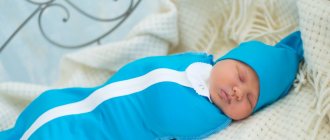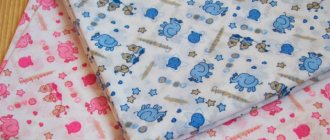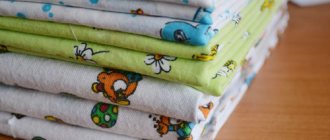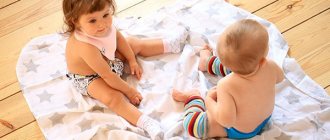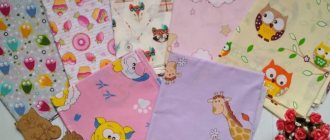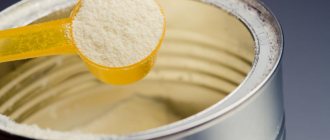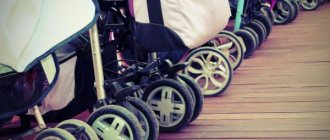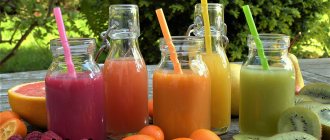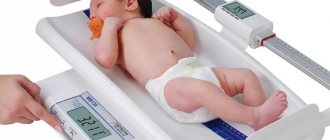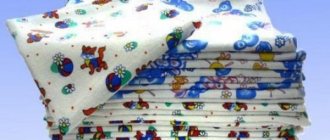Diaper cloth
As with any product for newborns, diapers are subject to increased requirements. They must be made from natural fabrics, be light, soft, absorb moisture very well, be durable and withstand endless washing. An important requirement is hypoallergenicity - the sensitive skin of babies can react with irritation to low-quality dyes and synthetics.
Natural cotton fabrics meet all these requirements:
- Chintz
- Calico
- Flannel
- Cotton knitwear
A guide to fabrics for children's clothing - what fabric are diapers for a newborn made from?
Many mothers, when preparing a dowry for their future baby, are faced with a difficult choice - from what fabric to buy diapers and first clothes for the newborn. We will tell you in detail about the main types of fabric for making children's clothing so that you can make the right choice.
In every list of necessary things for a newborn you will find warm and thin diapers, baby vests and caps. Warm items include products made from flannel and footer. Thin items are usually sewn from chintz, calico, kulirka and interlock. The ideal fabric for cocoon diapers and light swaddling systems is interlock. During swaddling, such a diaper allows you to securely secure the baby’s arms and legs, but does not overtighten, as it stretches well. For the cold season, it is better to choose interlock or footer as the first layer; for summer, rib and kulirka are perfect. The ideal fabric for warm overalls is velor and terry. Next we will talk in detail about most of the most popular fabrics.
Flannel is an ideal material for a newborn's first things; it is hypoallergenic, warm and soft. Flannel diapers, romper vests and caps traditionally become a baby's first clothing. If you need a warm diaper, a flannel diaper is the best option. In addition to softness and environmental friendliness, flannel’s high absorbent properties should be noted.
Taking care of flannel diapers and clothes is not burdensome. After washing, flannel clothes become even softer and more pleasant to the touch. It is important to note that washing flannel items in hot water can cause the item to shrink, so it is better to wash it in warm water. You should not rub the item vigorously, as pills quickly form on the material, which gives the item a sloppy appearance.
Footer is one of the most delicate and pleasant fabrics. Things and diapers made from footer are smooth on the outside, soft and delicate (as if brushed) on the inside, making them surprisingly gentle for newborns. The footer is made of cotton, which allows the skin to “breathe” while retaining warmth. The footer perfectly absorbs moisture and, at the same time, remains hypoallergenic. It also retains its shape perfectly, so the footer product does not stretch. Another important quality of things made from footer is durability: abrasions and wrinkles do not appear on the products. It is very important to wash footer clothes at 30 - 40 °C, since washing in hot water can seriously damage the product.
Calico is a very practical and unpretentious cotton fabric. Due to its high density, calico can be called one of the warmest fabrics and is perfect for diapers and bed linen. Calico diapers are easy to iron and equally easy to wash. They can withstand a large number of washes and are able to maintain the brightness of the pattern for many years. Calico allows air to pass through well, retains heat and absorbs moisture, which allows the skin to breathe.
Kulir or kulir stitch is the thinnest knitted cotton fabric. This is an ideal fabric for children's thin diapers and first clothes. The clothes it makes are very light and airy. These clothes are perfect for summer and as a first layer at any time of the year. The cooler is practically wrinkle-resistant, which means that unnecessary wrinkles will not appear on a newborn’s clothes. Despite its thinness, the cooler is quite durable.
Speaking about children's clothes for the summer, we should not forget about another representative of cotton fabrics - ribban weaving . Ribana is reminiscent of a pinstripe knit. A special feature of ribana is its elasticity due to the weaving of a rubber thread into the fabric, thanks to which the fabric perfectly holds its given shape. Items made from ribana are durable to use, they do not stretch, practically do not shrink, and are durable. You should remember several basic rules for caring for ribana products: do not twist the clothes after washing, it is better to easily wring them out by hand or in a washing machine, and do not dry them in the sun; it is better to do this in the fresh air, but avoid direct sunlight.
Chintz is a very thin, gauze-like fabric. Most often, thin diapers and vests are made from chintz. This material is very easy to care for - easy to wash and dry quickly. You don't have to iron it - just shake it before hanging to get rid of any heavy wrinkles.
Chintz is breathable and lightweight.
Interlock is a knitted fabric made from 100% cotton. This fabric is very soft and delicate, therefore it is used for sewing clothes for newborns. She is very pleasant to the body and it seems that she simply does not exist. The unique quality of interlock is that clothes practically do not stretch or unravel, and this has a beneficial effect on their service life. Interlock is absolutely harmless and suitable for children and adults with sensitive skin.
Velor is very delicate and soft, the surface of the velor consists of many fibers. The pile is located on the fabric in such a dense layer that it determines how velvety and cozy a velor product will be. Velor is very durable and does not lose its appearance and shape for a long time. No special care is required for velor clothing. It can be washed either by hand or in a washing machine at a temperature not exceeding 30 °C. Since velor clothes do not wrinkle or form wrinkles, there is no need to iron them.
Terry or loop fabric is a linen or cotton fabric, the surface of which is covered on one side with a pile of loops of threads. Terry is a very soft fabric that easily absorbs moisture in large quantities. Terry is a natural material, it is hypoallergenic and breathable. Towels for newborns and mittens for bathing are sewn from terry.
We really hope that our article will help you decide on the right choice of clothes for the most important person - your baby.
Diaper size
The simplest and most versatile baby diapers are rectangular. The size of baby diapers is usually 120 cm on one side and from 85 to 120 cm on the other. Chintz and flannel are often 95 cm wide, so when cutting it is convenient to use the full size and avoid trimming the fabric.
You can often find tables where the size of the diaper depends on the weight and age of the child. But, as practice has shown, it is more convenient to make diapers of the same size, and the extra 5 cm will not matter.
Currently, many interesting and useful things have been invented for newborns and babies that make the life of mother and child more comfortable. Diapers also went through improvements and were transformed into very interesting specimens, such as, for example, a cocoon diaper.
Strict requirements for materials
According to modern standards, baby diapers are fabric products that:
- consist of natural matter;
- soft and gentle to the touch;
- allow air to pass through;
- have good moisture permeability;
- are characterized by sufficient strength;
- have high-quality edge processing.
Cloth diapers intended for newborns are supposed to be protected from overheating and hypothermia. In products made from such fabric, the presence of rough seams is unacceptable. Any decorations in the form of frills, appliqués, etc. are also undesirable.
Types of diapers for newborns
There are various models of baby changing products. All of them are divided into two large groups:
| Varieties | Description |
| Reusable | Designed for regular change. Able to withstand frequent washing without problems. |
| Disposable | These are multi-layer options. After being used for their intended purpose, they are not washed, but thrown away. |
They also produce diapers in the form of a cocoon and overalls-envelope. They make the task easier for those parents who do not know how to swaddle.
Attention! Many manufacturers advertise improved models - waterproof. They contain a special membrane layer inside. Waterproof products are most often used while walking.
Photo gallery
Flannel bed linen
Pink plain dyed flannel
Flannel fabric
Scarlet flannel, plain dyed
Flannel bed linen
Checked flannel
Dress flannel
Flannel shirt
Flannel sets in bags
Flannel baby diapers
For children's underwear, it is printed flannel that is most often used: the dye that is applied to such material only on one side is absent from the inside, which means that the baby's skin does not come into contact with the dyes.
Flannel is used to make bonnets, rompers, and vests, but it is in the production of diapers that this material is most often used.
Such products turn out to be soft and very warm, and if you compare their cost with other similar materials, purchasing flannel diapers is much more profitable.
Flannel has not lost its relevance as a material for baby diapers for a long time for the following reasons:
- Flannel is a wear-resistant material , so diapers made from this material can withstand a large number of washes, but children’s clothes have to be washed very often;
- This soft material does not irritate children's skin ;
- Flannel does not shrink and absorbs moisture well , so this fabric makes ideal diapers for newborns;
- Due to their thickness, flannel diapers, folded several times, can be used as pads in strollers.
Flannel fabric
There are certain standards for the size of flannel diapers, but they are all large sizes: 120x75 or 120x90 centimeters, a less common size is 150x100 centimeters.
Such sizes can be explained by the fact that these products are used not only for swaddling, but also for placing under the baby in a stroller or on a changing table in a hospital, and in this case the sheet has to be folded several times.
The cost of one such diaper is on average 100-130 rubles, but the price for one and a half meter diapers is much higher.
Advantages and disadvantages
The positive qualities of flannel are as follows:
- The material is soft to the touch and gets softer with every wash;
- The high density of the weave of the threads makes it possible to achieve the strength and wear resistance of flannel;
- Flannel warms up quickly and retains heat well;
- This natural fabric does not cause allergic reactions;
- No special conditions are required to care for flannel.
- The disadvantages of flannel include the formation of pilling over time, the fabric taking a long time to dry after washing or getting wet, as well as the strong wrinkling of some types of flannel (however, the material is also easily smoothed out).
Required number of diapers
Having remembered a little basic mathematics, you can calculate their required number. It's better to think through all the use cases. So, let's get started:
- For a changing table you will need two or three pieces. While one is in the wash, a new one is being made. All hygiene procedures will be carried out on them.
- You will need about three pieces for the crib. Babies often spit up; it’s easier to spread a diaper than to change bed linen several times a day.
- Two pieces for a stroller. Also for protecting inner textiles. In the summer - a few more pieces to cover the baby.
- 2-3 diapers for wiping after washing.
- Well, for the swaddling itself you will need at least 10 pieces.
The result is 20 - 25 pieces. This is the number of diapers a newborn needs for the first time. Minimum required. All children are different. Some people burp often, others less often. There are parents who do not use diapers to the maximum. In such cases, it’s worth stocking up on at least ten more pieces. Subject to regular washing. Babies born in winter will benefit from a few warm flannel swaddles for extra coverage.
Recommendation: Don’t worry if the question about quantity puts you in a difficult situation. It’s worth checking out forums for young mothers and chatting with friends who recently had a baby. Each mother chooses the appropriate option for herself. After listening to different opinions, you can estimate how many diapers you will need.

